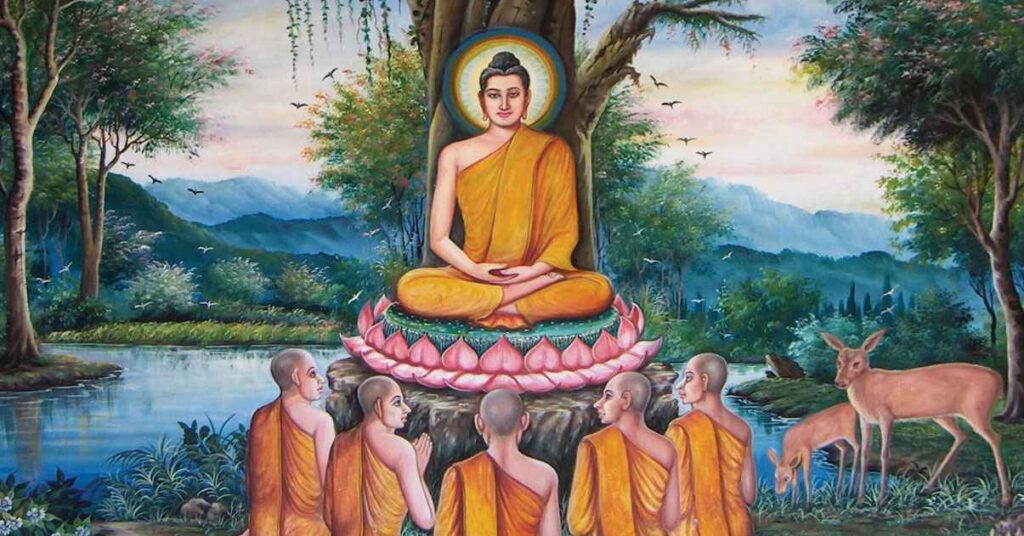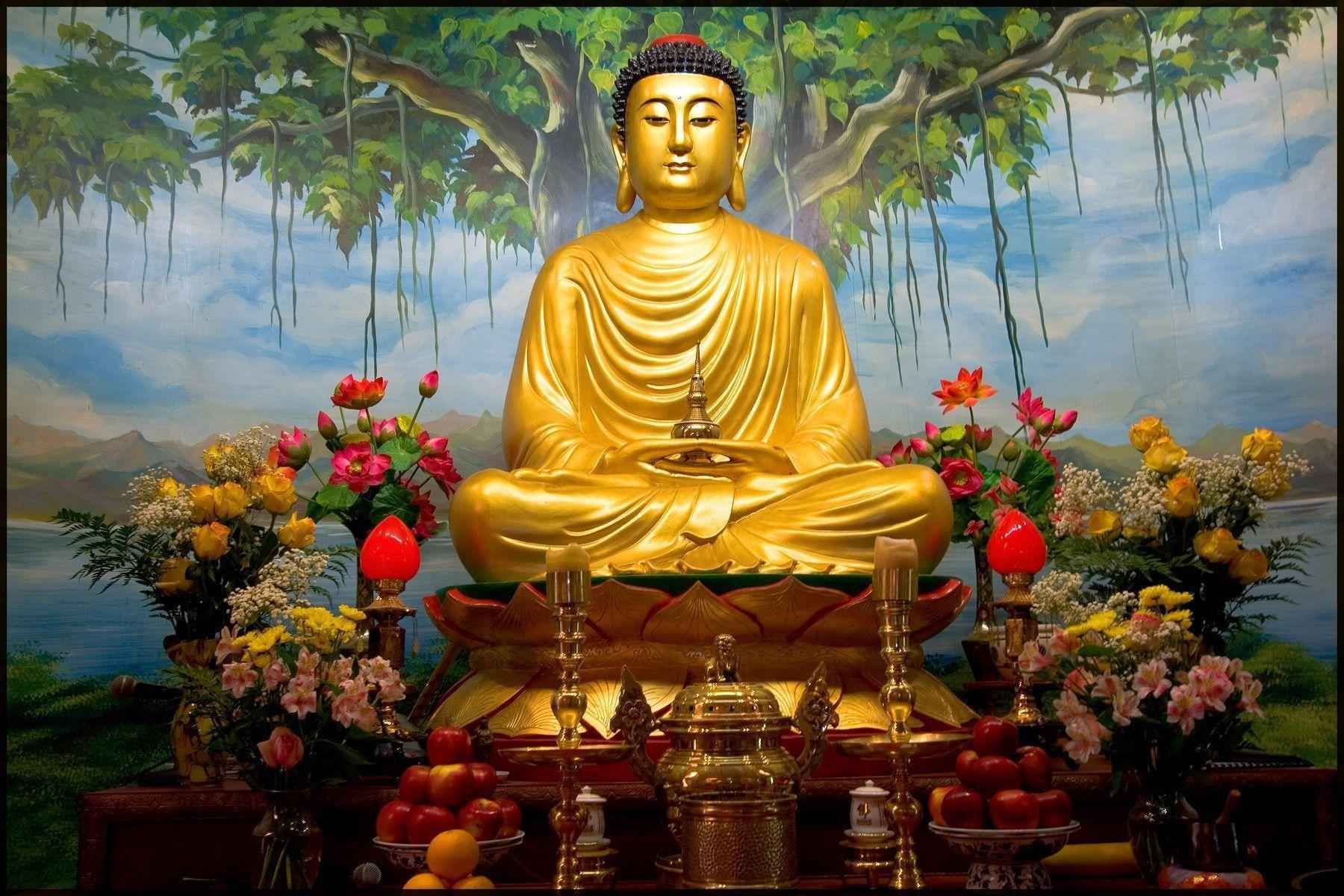Gautama Buddha: The Enlightened Sage
Siddhartha Gautama, born around 563 BCE in Lumbini (modern-day Nepal), was a Hindu prince. Legend has it that a prophecy foretold he would become either a powerful king or a great spiritual leader. His father, fearing the latter, shielded him from suffering and worldly realities for 29 years.
However, Siddhartha’s curiosity led him to venture beyond the palace walls. Witnessing the Four Signs—an aged man, a sick man, a dead man, and a religious ascetic—he realized the impermanence and suffering inherent in life. Determined to find answers, he renounced his princely life and embarked on a spiritual quest.
Under the Bodhi tree in Bodh Gaya, Siddhartha meditated intensely. After profound insights, he attained enlightenment and became the Buddha (“the awakened one”). He preached the Four Noble Truths, emphasizing detachment, the Wheel of Becoming, and the Eightfold Path to enlightenment.
His teachings spread across India and beyond, shaping Buddhism—a major world religion with millions of followers today. The Buddha’s legacy lies in his profound wisdom, compassion, and the path to liberation from suffering.
Early Life and Awakening

Birth and Royalty
- Siddhartha Gautama was born into a wealthy family in the small Shakya Republic, located in what is now modern-day Nepal.
- As a prince, he enjoyed a life of luxury and privilege within the palace walls.
The Quest for Enlightenment
Moved by Suffering
- Siddhartha Gautama, a Hindu prince, witnessed the profound suffering of humanity—aging, sickness, and death.
- This moved him deeply, prompting him to seek answers beyond the material comforts of his royal life.
The Great Renunciation
- Determined to find a solution, Siddhartha renounced his princely life.
- He left behind his palace, family, and worldly possessions to embark on a spiritual journey.
The Great Renunciation
Leaving the Palace
- Siddhartha Gautama, born into wealth and luxury, felt compelled to explore the deeper truths of existence.
- He left his opulent palace, bidding farewell to family, comfort, and worldly possessions.
The Quest for Solutions
- Driven by compassion and a desire to alleviate human suffering, Siddhartha embarked on a spiritual journey.
- His pursuit led him to the path of meditation, self-discovery, and enlightenment.
The Path to Enlightenment
- The Bodhi Tree:
- Siddhartha Gautama, later known as the Buddha, sought enlightenment under the Bodhi tree in Bodh Gaya, India.
- After intense meditation and inner struggle, he transcended ignorance and realized the Four Noble Truths.
- The Bodhi tree symbolizes awakening, wisdom, and liberation.
- The Four Noble Truths:
- These fundamental teachings form the core of Buddhism:
- Dukkha (Suffering): Life involves suffering, dissatisfaction, and impermanence.
- Samudaya (Cause): Suffering arises from craving and attachment.
- Nirodha (Cessation): To end suffering, one must eliminate craving and attain nirvana.
- Magga (Path): The Noble Eightfold Path provides a practical guide to liberation.
- These fundamental teachings form the core of Buddhism:
Spread of Buddhism
- Teachings and Disciples:
- The Buddha emphasized:
- The Four Noble Truths:
- Suffering exists (dukkha).
- The cause of suffering is craving and ignorance.
- Suffering ends by eliminating craving and ignorance.
- The Noble Eightfold Path leads to liberation.
- Ethical conduct, mindfulness, meditation, and compassion.
- The Four Noble Truths:
- The Buddha emphasized:
Ashoka the Great
- Ashoka’s Empire:
- Ashoka ruled over a vast empire that extended from present-day Afghanistan in the west to Bangladesh in the east.
- His capital was Pataliputra (modern-day Patna).
- Kalinga War and Transformation:
- In his eighth regnal year (around 260 BCE), Ashoka waged a brutal war against Kalinga (modern Odisha).
- The immense suffering and loss of life during this war deeply affected him.
- Conversion to Buddhism:
- After the Kalinga War, Ashoka embraced Buddhism.
- He propagated “dhamma” (righteous conduct) through his edicts, emphasizing non-violence, compassion, and moral principles.
Gautama Buddha: Legacy and Influence
Gautama Buddha, also known as Siddhartha Gautama, was a wandering ascetic and religious teacher who lived in South Asia during the 6th or 5th century BCE. Born in Lumbini (now in Nepal), he renounced his royal life to seek enlightenment. After intense meditation, he attained nirvana at Bodh Gaya in India. The Buddha then wandered, teaching and establishing a monastic order. His core teachings include the Four Noble Truths and the Noble Eightfold Path, emphasizing freedom from ignorance, craving, rebirth, and suffering.
Global Impact
Buddhism spread beyond India, influencing most of Asia. Let’s explore its impact in different regions:
- Southeast Asia: Buddhism reached Malaysia, Indonesia, and Sumatra by the early centuries CE. Indian missionaries played a crucial role, and by the 7th century, Srivijaya (Sumatra) had a Buddhist king.
- East Asia: In Vietnam, Buddhism connected with China. Japan embraced Buddhism through Chinese and Korean channels. Tibetan Buddhism also influenced Mongolia and parts of China.
Tolerance and Evolution
Buddhism’s adaptability is remarkable. It emphasizes inner transformation rather than rigid dogmas. Some scholars view it as a spiritual tradition rather than an organized religion. Its teachings continue to evolve, addressing contemporary challenges while maintaining timeless wisdom.
In summary, Gautama Buddha’s legacy extends across continents, shaping diverse cultures and minds. Buddhism’s enduring influence lies in its ability to adapt, inspire, and offer a path toward inner awakening.
FAQ’s
Q. Who was Gautama Buddha?
A: Gautama Buddha, also known as Siddhartha Gautama, was a spiritual teacher and the founder of Buddhism. He lived in ancient India around the 6th to 4th century BCE and is considered the “Awakened One” who attained enlightenment and shared his insights to help others achieve the same.
Q. What is the significance of Gautama Buddha’s teachings?
A: Gautama Buddha’s teachings, known as the Dharma, focus on the Four Noble Truths and the Eightfold Path. They emphasize the importance of ethical conduct, mental discipline, and wisdom as a means to overcome suffering and attain enlightenment.
Q. How did Gautama Buddha attain enlightenment?
A: Gautama Buddha attained enlightenment after meditating under the Bodhi tree in Bodh Gaya, India. He realized the true nature of existence, the causes of suffering, and the path to liberation.
Q. What is the historical significance of Gautama Buddha?
A: Gautama Buddha’s life and teachings have had a profound impact on millions of people worldwide. Buddhism, the religion based on his teachings, has spread across Asia and the world, influencing cultures, philosophies, and spiritual practices.












